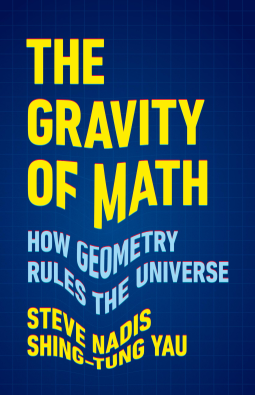
The Gravity of Math
How Geometry Rules the Universe
by Steve Nadis; Shing-Tung Yau
This title was previously available on NetGalley and is now archived.
Buy on Amazon
Buy on BN.com
Buy on Bookshop.org
*This page contains affiliate links, so we may earn a small commission when you make a purchase through links on our site at no additional cost to you.
Send NetGalley books directly to your Kindle or Kindle app
1
To read on a Kindle or Kindle app, please add kindle@netgalley.com as an approved email address to receive files in your Amazon account. Click here for step-by-step instructions.
2
Also find your Kindle email address within your Amazon account, and enter it here.
Pub Date Apr 16 2024 | Archive Date Apr 16 2024
Description
"A must-read.”―Avi Loeb, New York Times–bestselling author of Extraterrestrial
One of the preeminent mathematicians of the past half century shows how physics and math were combined to give us the theory of gravity and the dizzying array of ideas and insights that has come from it
Mathematics is far more than just the language of science. It is a critical underpinning of nature. The famed physicist Albert Einstein demonstrated this in 1915 when he showed that gravity—long considered an attractive force between massive objects—was actually a manifestation of the curvature, or geometry, of space and time. But in making this towering intellectual leap, Einstein needed the help of several mathematicians, including Marcel Grossmann, who introduced him to the geometrical framework upon which his theory rest.
In The Gravity of Math, Steve Nadis and Shing-Tung Yau consider how math can drive and sometimes even anticipate discoveries in physics. Examining phenomena like black holes, gravitational waves, and the Big Bang, Nadis and Yau ask: Why do mathematical statements, derived solely from logic, provide the best descriptions of our physical world?
The Gravity of Math offers an insightful and compelling look into the power of mathematics—whose reach, like that of gravity, can extend to the edge of the universe.
One of the preeminent mathematicians of the past half century shows how physics and math were combined to give us the theory of gravity and the dizzying array of ideas and insights that has come from it
Mathematics is far more than just the language of science. It is a critical underpinning of nature. The famed physicist Albert Einstein demonstrated this in 1915 when he showed that gravity—long considered an attractive force between massive objects—was actually a manifestation of the curvature, or geometry, of space and time. But in making this towering intellectual leap, Einstein needed the help of several mathematicians, including Marcel Grossmann, who introduced him to the geometrical framework upon which his theory rest.
In The Gravity of Math, Steve Nadis and Shing-Tung Yau consider how math can drive and sometimes even anticipate discoveries in physics. Examining phenomena like black holes, gravitational waves, and the Big Bang, Nadis and Yau ask: Why do mathematical statements, derived solely from logic, provide the best descriptions of our physical world?
The Gravity of Math offers an insightful and compelling look into the power of mathematics—whose reach, like that of gravity, can extend to the edge of the universe.
Available Editions
| EDITION | Other Format |
| ISBN | 9781541604292 |
| PRICE | $32.00 (USD) |
| PAGES | 272 |
Available on NetGalley
NetGalley Shelf App
(EPUB)
Send to Kindle (EPUB)
Download (EPUB)



